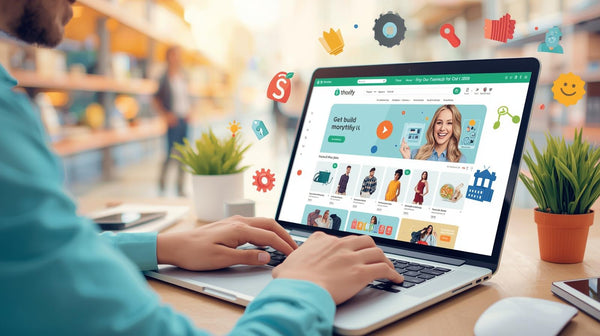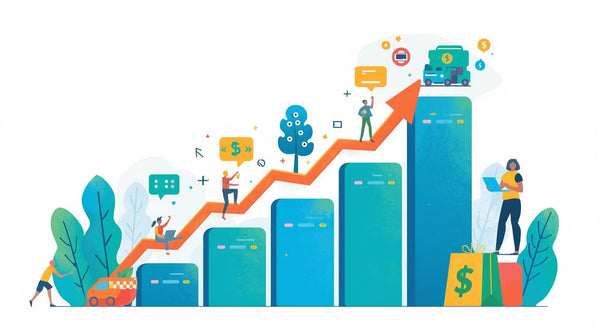Facebook Ad Library: The Competitive Edge for Shopify Store Owners
If you run a Shopify store in 2025, your competitors are not just the boutique downtown or the store two suburbs over they’re brands in New York, Berlin, and Sydney, all chasing the same clicks, carts, and conversions. And here’s the kicker: some of them are running campaigns armed with nothing but guesswork, while others are working with something close to an unfair advantage.
That advantage is the Facebook Ad Library. Think of it as a public window into the ads other businesses are running not just the visuals, but the exact messages, formats, and even timing they’re using to reach their audience. It’s not about stealing ideas. It’s about studying the market in real time, spotting trends as they happen, and avoiding the expensive trial-and-error that eats up ad budgets.
In this post, we’re going to break down how to actually use the Facebook Ad Library to sharpen your Shopify advertising strategy, keep your creative fresh, and ensure you’re not wasting money on campaigns that were doomed from the start. We’ll cover how to search it, what patterns to look for, the smart way to draw inspiration without copying, and why this single free tool can often reveal more about your industry than hours of paid research.

What Is the Facebook Ad Library?
The Facebook Ad Library is one of the most underrated tools in digital marketing yet it’s hiding in plain sight. Built and maintained by Meta, it’s a public, searchable database that shows every active ad running across Facebook, Instagram, Messenger, and the Audience Network. You don’t need a Facebook account. You don’t need special access. It’s free, open to everyone, and updates in real time.
Originally, Meta launched the tool in response to concerns over political and issue-based advertising, aiming to make ads more transparent. But the transparency that was meant for public accountability quickly became a game-changer for marketers. Suddenly, anyone could peek into what other brands big or small were promoting, and how they were doing it.
For Shopify store owners, the Facebook Ad Library isn’t just an interesting curiosity. It’s a live snapshot of your market. Instead of relying solely on keyword research or guessing at trends, you can actually see:
-
Which products are being promoted most often in your niche.
-
How competitors are structuring their ad creatives and copy.
-
What type of offers, discounts, or bundles seem to be in play.
-
How different brands are adapting to seasons, holidays, or trending topics.
Think of it as walking into a competitor’s marketing war room except you’re not breaking any rules or crossing any ethical lines. It’s all public information that Meta makes available intentionally. The trick is knowing how to filter, interpret, and apply what you find.
And here’s the real beauty: the Facebook Ad Library doesn’t just show one or two ads. If a brand is running dozens of variations for split testing, you’ll see them all. This means you can start spotting patterns in ad format, tone, colors, audience targeting style that reveal a lot about what’s likely working for them.
For a Shopify entrepreneur in 2025, where competition comes from every direction, this is no longer optional knowledge. It’s an always-on research lab that can keep your marketing sharp, relevant, and competitive without the trial-and-error that drains ad budgets.

Why Shopify Store Owners Should Pay Attention
If you’ve ever run Facebook or Instagram ads for your Shopify store and watched the clicks trickle in without a single sale, you already know the pain and the price of marketing guesswork. Every wrong move on Facebook Ads costs real money, and if you’re competing in ecommerce in 2025, the wrong approach can burn through your budget faster than you can say “add to cart.”
That’s exactly where the Facebook Ad Library steps in. It takes the blindfold off. Instead of gambling with your creatives, offers, and targeting, you can study what’s already performing in your market before you even hit “publish.”
By digging into competitor ads, you can:
-
Spot design trends that resonate with your audience
Maybe you notice that many successful Shopify brands in your niche are leaning toward clean product photography with bold text overlays, or perhaps lifestyle shots are winning out over plain backgrounds. These patterns give you a visual direction before you start designing your own campaigns. -
Discover seasonal campaigns that actually get traction
Let’s say you sell home décor. A quick browse in the Ad Library during November might reveal that competitors are heavily pushing “cozy winter bundles” or limited-edition holiday colors. That’s a clear sign that customers expect seasonal offers and you can plan yours before the season hits full swing. -
Understand pricing and offer structures in your market
You can see whether your competitors rely on “50% off” urgency tactics, free shipping incentives, bundle deals, or loyalty perks. This gives you a benchmark to make sure your offers are competitive without undercutting your profits. -
Avoid reinventing the wheel every time you launch a campaign
The Facebook Ad Library is a living archive. Instead of starting every ad brainstorm from scratch, you can build from proven ideas, adapt them to your brand voice, and skip past months of costly trial and error.
And here’s the key point the goal isn’t to copy. Copying kills originality, and your audience can spot a clone a mile away. The real opportunity is in learning the principles behind successful ads, then applying them in a way that’s unique to your brand.
In other words, the Facebook Ad Library isn’t about stealing your competitor’s recipe it’s about understanding the ingredients they’re using so you can cook up something even better.

How to Use the Facebook Ad Library Step-by-Step
The Facebook Ad Library might look simple at first glance, but when you use it strategically, it becomes a research powerhouse. Here’s exactly how to get the most out of it, step by step.
1. Go to the Facebook Ad Library Website
You can find it in seconds with a quick Google search for “Facebook Ad Library.” No login, no account, no special tools needed. It’s completely open to the public, which means even if you’re not running ads yet, you can still explore what others are doing.
2. Select the Right Country
This step is crucial. Ads are often geo-targeted, and what works in Canada might not work in Australia or the UK.
If your Shopify store sells internationally, you can search in multiple countries to compare trends. For example, you might notice that in the U.S., brands focus on free shipping, while in Europe, they emphasize sustainable packaging. That’s insight you can use to tailor campaigns per region.
3. Search by Brand Name, Keyword, or Product Type
Think of this like Googling your competitors but for ads.
-
By brand name: See exactly how competitors position themselves, their offers, and their visuals.
-
By keyword: Perfect if you don’t know who your competitors are yet. For example, searching “yoga mat” reveals dozens of brands targeting that market.
-
By product type: This is ideal for spotting niche trends. Selling handmade candles? Search “soy candle” and see what’s popping.

4. Analyze the Creative
Don’t just glance at an ad dissect it. Look at:
-
Images or videos: Are they product-focused, lifestyle-oriented, or animated?
-
Headline & text: Is the language urgent, emotional, or purely descriptive?
-
Call-to-action (CTA): Are they pushing “Shop Now,” “Learn More,” or something more playful?
-
Brand voice & tone: Are they friendly and conversational or formal and authoritative?
This is where you’ll start spotting patterns across successful ads in your niche.
5. Check Ad Longevity
If an ad has been running for weeks or even months, it’s a strong sign that it’s performing well. Advertisers rarely keep spending on an underperforming campaign.
Look for ads with long run times these are your best indicators of what’s resonating with customers right now.
6. Save Examples
Don’t rely on memory. Create a folder (digital or physical) where you save screenshots, notes, and ideas from the ads you like.
Organize them by:
-
Campaign type (product launch, seasonal promo, clearance sale)
-
Visual style (product photos, lifestyle shots, user-generated content)
-
Offer type (discount, free shipping, limited edition)
Over time, this library becomes your own cheat sheet tailored to your niche and audience.
Insights You Can Extract
The Facebook Ad Library isn’t just a showcase of ads it’s a goldmine of market intelligence if you know what to look for. The goal isn’t to copy what others are doing but to spot the patterns that drive performance in your niche.
1. Offer Frequency How Often Do They Run Discounts?
Watch how frequently your competitors drop sales or promotions.
-
If they run discounts all year round, they may be training customers to never buy at full price.
-
If they run occasional, limited-time offers, they may be leveraging scarcity and urgency for higher margins.
Example: If you see a big push for “Buy One Get One” campaigns every three months, it might align with inventory cycles a sign you could time your own promotions accordingly.
2. Creative Formats What Works in Your Niche?
Notice whether the leaders in your space are using:
-
Static images: Quick to produce, clean, and direct.
-
Video ads: Great for storytelling, product demos, or influencer testimonials.
-
Carousel ads: Multiple products in one swipe perfect for variety stores.
-
GIFs or animations: Lightweight, eye-catching movement without full video production costs.
If 80% of ads in your niche are short videos, that’s a sign you should test video-first campaigns.
3. Language Style What Tone Converts?
Look closely at how ads are written:
-
Conversational: Feels personal and friendly (“We’ve got something just for you.”)
-
Urgent: Pushes quick action (“Ends tonight!” or “Only 3 left in stock.”)
-
Luxury-focused: Uses aspirational language (“Experience elegance with every sip.”)
-
Educational: Informative and trust-building (“Did you know this material is 100% recycled?”)
This helps you fine-tune your own Shopify store’s brand voice to match (or strategically differ from) the market.

4. Seasonality When Do Ads Spike?
Scroll through your competitors’ ad timelines to see when they invest heavily.
-
Back-to-school season
-
Black Friday/Cyber Monday
-
Valentine’s Day
-
Summer product launches
By spotting these seasonal pushes, you can plan your marketing calendar months ahead and ride the wave of increased consumer demand.
Advantages of the Facebook Ad Library
From a Shopify business perspective, the Facebook Ad Library is like having a 24/7 spyglass into your market and it doesn’t cost a dime. Here’s why it’s a must-have in your marketing toolkit:
1. Free Access No Subscription Fees
Unlike premium competitor analysis tools, the Facebook Ad Library is 100% free. Whether you’re a solo entrepreneur or running a large e-commerce operation, you can tap into global ad data without adding another software expense.
2. Competitor Visibility See Exactly What Other Stores Are Doing
You can check the active campaigns of any Shopify competitor, from small boutiques to multinational brands. This lets you:
-
See how they position their products
-
Track their promotional cycles
-
Identify their most common ad formats
3. Creative Inspiration Avoid Creative Blocks Before a Campaign
When you’re stuck on ad copy or design ideas, browsing a variety of ads in your niche can jump-start creativity. You can spot:
-
Effective headlines
-
High-performing visual styles
-
Unique call-to-action phrases
4. Trend Spotting Stay Ahead of Design and Messaging Shifts
The Ad Library lets you see creative and strategic shifts as they happen such as a move from static images to short-form videos, or from “sale” messaging to “sustainability” messaging. Early adopters often gain a competitive edge.

5. Market Research Shortcut Faster Than Commissioning a Full Competitor Analysis
Traditional market research can take weeks and cost thousands. With the Ad Library, you can gather actionable insights in hours. It’s not a complete replacement for in-depth research, but it’s an invaluable first step.
6. Seasonal Strategy Alignment
By checking the timing of competitors’ ads, you can align your own campaigns with high-demand seasons (e.g., holiday shopping, back-to-school, summer travel gear) without guesswork.
7. Proof of Concept Testing
If you notice multiple competitors running a similar type of ad for months, it’s often a sign the campaign is delivering strong results giving you a green light to test similar approaches.
8. Cross-Market Discovery
You can research not only your local market but also see what’s working internationally. This opens up inspiration from industries and regions you might never have considered.
9. Ad Longevity Insight
Seeing how long an ad has been running helps you gauge performance short-lived ads may have flopped, while long-running ads are likely proven winners.
10. Low-Risk Learning Environment
Instead of spending money to “test everything yourself,” you can first learn from what’s already working for others, reducing your own trial-and-error costs.
Bottom Line: The Facebook Ad Library turns every competitor’s marketing spend into a learning opportunity for free. It’s one of the most underused, high-leverage tools available to Shopify entrepreneurs.

Common Mistakes to Avoid
Even though the Facebook Ad Library is simple to use, Shopify store owners often miss its full potential by falling into these traps:
1. Blindly Copying Competitor Ads Without Tailoring Them to Your Audience
It’s tempting to just duplicate what you see from competitors, but that often backfires. Your brand voice, customer pain points, and unique selling proposition may differ. Inspiration is valuable imitation without adaptation is risky.
2. Only Checking Once Instead of Tracking Over Time
One quick look gives you a snapshot, but not the full story. Successful marketing decisions come from spotting patterns over weeks or months like recurring sales periods, seasonal messaging, or shifts in ad formats.
3. Ignoring Your Own Analytics and Relying Solely on What Others Do
Your own data is your most reliable guide. Even if a competitor’s ad looks successful, it may not resonate with your specific audience. Combine Ad Library insights with your Shopify analytics, Facebook Ads Manager data, and customer feedback.
4. Forgetting About Mobile Optimization
More than half of Facebook traffic is mobile. Even if your ad is great, a slow or poorly designed mobile landing page will kill conversions. Always check:
-
Mobile load speed
-
Layout clarity
-
Button size and placement for touchscreens
5. Misreading Ad Longevity
Just because an ad has been running for a long time doesn’t guarantee it’s performing well — sometimes brands keep ads active due to oversight or internal politics. Always verify trends with other data points.
6. Focusing Only on Competitors in Your Exact Niche
While it’s useful to study direct competitors, some of your best creative ideas might come from related industries with similar target demographics.
7. Overlooking Ad Copy Nuances
Many store owners focus solely on images or videos, forgetting that headlines, captions, and calls-to-action drive clicks. A mediocre visual can perform well with powerful copy and vice versa.
Takeaway: The Facebook Ad Library is a goldmine but like any tool, its value depends on how you use it. Avoid these mistakes, and you’ll turn raw competitor data into actionable marketing insights.

Advanced Ways Shopify Agencies Use It
For professional Shopify agencies like EcomSpiders, the Facebook Ad Library is not just a curiosity tool it’s a strategic advantage. Here’s how we weave it into a bigger, data-driven approach:
1. Cross-Referencing Ad Trends with Shopify Analytics
We don’t just look at ads we line them up with real store performance data. If we notice that a competitor’s “Free Shipping” campaign aligns with a sudden spike in our client’s niche sales, we know that offer style has market pull.
2. Testing Competitor Offer Styles with Low-Budget Campaigns
Instead of committing to a full-scale ad spend, we run micro-tests inspired by successful competitor formats for example, switching from static images to short-form videos to see how our audience reacts before scaling.
3. Building Swipe Files for Creative Brainstorms
We create organized swipe files categorized by ad format, copy style, audience targeting cues, and seasonal relevance. This library becomes a constant source of fresh ideas for future campaigns, speeding up creative turnaround.
4. Spotting Under-Served Niches
By scanning hundreds of ads in a niche, we can see what’s missing. For example, if we notice no one is advertising eco-friendly packaging in a high-volume beauty market, that’s a potential gap our clients can fill first.
5. Identifying Seasonal Opportunities Before They Peak
We look for early signals like a sudden wave of “Back-to-School” campaigns in July and align our clients’ promotions ahead of the curve, rather than competing in the middle of the rush.
6. Refining Ad Copy Angles with A/B Insights
If multiple brands are pushing similar offers but only a few gain traction, we analyze their headline tone, emotional triggers, and urgency cues to understand what’s resonating and adapt accordingly.
Pro Tip: This approach turns the Facebook Ad Library from a browsing tool into a predictive marketing system. By combining it with Shopify store data, ad managers can make informed decisions that outpace competitors who only use it for curiosity checks.

Facebook Ad Library + Shopify Growth
The Facebook Ad Library becomes far more powerful when it’s not just a source of inspiration but a direct input into your Shopify growth strategy. Here’s how to make that connection work:
1. Use Competitor Ad Ideas to Test New Product Angles
If a competitor is running multiple ads around a product bundle or limited edition color, that’s a signal it’s performing. Use Shopify’s product duplication and tagging features to quickly create your own test product variation and run a small ad campaign to see if your audience bites.
2. Refine Your Store’s Homepage to Match Ad Expectations
If your ads promise “free next-day delivery” or “exclusive summer deals,” your Shopify homepage needs to deliver that message instantly. Match hero images, banners, and calls-to-action so shoppers feel a seamless transition from the ad to your store.
3. Align Promotions with Proven Seasonal Trends
By spotting seasonal spikes in competitor ads (like fitness gear in January or outdoor furniture in April), you can schedule Shopify discount codes, banner promos, and homepage updates to go live right before the rush beating the competition to market.
4. Run A/B Tests Inspired by Long-Running Competitor Ads
Long-running ads are usually profitable ads. Use their structure headline style, image placement, video length to design two or three variations for your own products in Shopify’s connected ad manager. Then monitor conversion rates in your analytics dashboard to decide your winning version.
5. Match Ad Messaging with Product Page Copy
If an ad is built around “eco-friendly” benefits, but your product page never mentions it, you’re creating friction. Mirror the emotional and practical selling points from successful ads right inside your Shopify product descriptions.
6. Create Quick-Launch Campaigns Using Pre-Tested Formats
When you need to move fast (holiday season, viral trends), pull a proven ad format from your Facebook Ad Library research and plug it into a Shopify automation flow complete with matching upsells, abandoned cart sequences, and email follow-ups.
The Bottom Line: The Facebook Ad Library is your research lab, and Shopify is your launch pad. The magic happens when you stop treating them as separate tools and start running them as a single, connected growth engine.

Final Thoughts + Free Consultation Offer
The Facebook Ad Library is not a “spy tool” it’s a public resource for smart marketers. If you run a Shopify store and you’re not using it, you’re leaving easy insights on the table.
The most successful Shopify brands in 2025 aren’t just running ads; they’re running smarter ads based on data, observation, and consistent testing.
At EcomSpiders, we help Shopify store owners turn competitor insights into high-performing ad campaigns. If you want to make your Facebook ads more effective or even rebuild your store for better conversions we offer a free consultation to get you started.





0 comments